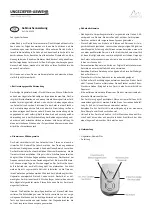
6. PERIODICAL MAINTENANCE
The need for and the required frequency of maintenance results from analogical requirements of the
installation including RK370 or V370 valves. If no specific requirements have been defined for
periodical maintenance of the installation, or if the periods between particular checks are longer than
six months, check the RK370 or V370 valves at least once every
six months. This is the responsibility of the Facility Owner.
Periodical maintenance of RK370 or V370 valves comprises the
assessment of their physical condition, and correct operation using
the Inspection Document at the end of this Documentation.
It is also recommended to assess the condition of the device using
the Inspection Document after the end of assembly works and
launch of the installation including the RK370 or V370 valves. In
order to check correct valve operation, do the following:
6.1.
HO and HE versions – release manual lever (item 1 Fig.
13) from the catch (item 2 Fig. 13) keeping the valve open. After
releasing the lever, it moves freely from the open to closed position,
closing the valve partition. Next, manually open the valve, and hook
the manual lever (item 1) at the element (item 2). For valves in HE
version, during the test, observe correct signalling by micro-switch
(item 3) of cut-off partition's position.
If irregularities are found, set the micro-switch actuation point (item
3).
6.2.
MR version – disconnect power supply to the solenoid. The
partition should move to the closed position. Then disconnect the
solenoid’s power supply. In MR version, manually turn the manual
lever, leading to contact of the keeper and the solenoid. After the partition
achieves open position, the manual lever will be blocked by resistance of the
keeper against solenoid coil, and valve partition will remain open, kept by the
solenoid. During the test, in both cases, observe correct signalling by micro-
switch of cut-off partition's position. In the event of problems with sustaining the
partition, check for cleanliness of keeper and solenoid surface.
6.3.
ER version – disconnect power supply to the BELIMO
actuator.
The
valve must close (signalled by the steel arrow installed at the actuator axle at
“0°” position of the scale (Fig. 15 item 1).
Operation of the air-handling installation with dysfunctional fire valves bears the high risk of their
non-performance in the event of a fire, and makes the installation user liable.
Open
O
p
e
n
C
lo
se
d
Close
Fig. 13
Fig. 15



































